Hammerhead is not a Poseidon killer, he is a host killer
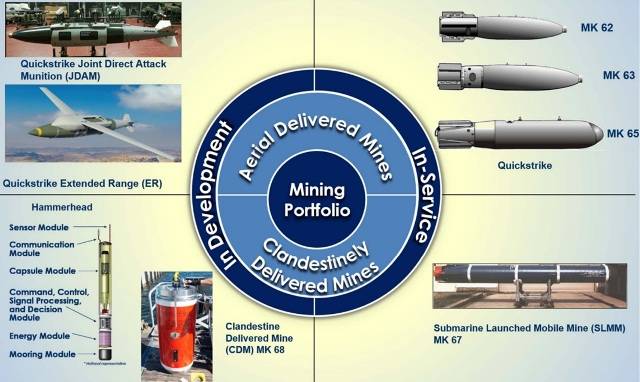
Taking into account the hype in the media (both ours and foreign) the topic of deep-sea super torpedoes "Status-6 / Poseidon", a number of media, almost all military-technical events in the field of naval weapons are considered "through them". Among them were news on the deployment of the US Navy's work on the development of a new broadband (with a large area of destruction and a torpedo warhead) Hammerhead mine, which in some media was called the "Poseidon's killer."
This is, to put it mildly, somewhat wrong. And not only because "Poseidon" as a serial system weapons not yet.
Hammerhead vs. Poseidons.
The defeat of a high-speed deep-water object ("Status-6 / Poseidon") is possible only with a nuclear weapon or a small-sized high-speed torpedo (anti-torpedo) with a powerful deep-sea power plant (for example, Mk50 or ATT).
Successful targeting of Status-6 / Poseidon torpedoes with significantly weaker energetics (piston engines fueled by unitary fuel) of the Mk46 and Mk54 types is possible only with the starting position of this torpedo practically on the Status-6 / Poseidon course. However, the open cycle (with exhaust into the water) of these power plants excludes the preservation of high performance characteristics at a kilometer depth, respectively, the probability of hitting a Status-6 / Poseidon-type target for a torpedo-warhead of a mine complex is close to zero (or even impossible).
Note: Theoretically, the creation of non-contact detection equipment that makes it possible to issue the necessary target designation of a torpedo mine is possible, but the cost of such a mine will exceed all reasonable limits.
For this reason, the most effective way to destroy the "Status-6 / Poseidon" is the use of high-speed deep-sea torpedoes (anti-torpedoes) for high-precision target designation developed aviation search and sighting system of anti-submarine aircraft. At the same time, the initial detection was provided by a stationary (and mobile, if necessary) system for lighting the underwater environment. And this was well recognized in the United States and the USSR back in the 80s (that is, at the time of the development of work on the topic of "Status-6").
At the same time, mine weapons are extremely dangerous for the submarines themselves, including potential carriers of Status 6 / Poseidon.
Anti-submarine torpedo mine CAPTOR
Work on torpedo bombs in the US Navy began back in 1960. At the initial stage of development, there were hopes that a broadband mine would reduce the usual costs of laying mines by two (!) Orders of magnitude ... In reality, it turned out to be completely different. For example, the radius of the danger zone of a broadband mine is about 30 times the radius of the danger zone of a bottom mine, while the cost of the first (CAPTOR) in fiscal 1986 was $ 377 (in 000 fiscal year - $ 1978), and the second was less than $ 113 thousand in prices of the early 000s.
Testing of the CAPTOR prototypes began in 1974, however, the high complexity of the task led to the fact that the initial operational readiness was achieved by CAPTOR only in September 1979. Full-scale production (15 per month) was approved in March 1979. At that time, the initial plans of the US Navy included the purchase of 5785 CAPTOR mines. However, reliability problems led to a production halt in 1980 (relaunched in 1982). Fiscal 1982 - 400 Mk60 CAPTOR mines.
Subsequent purchases: 1983 - 300 Mk60; 1984 - 300 Mk60; 1985 - 300 or 475 (according to various sources) Mk60. The delivery of 600 Mk60 in 1986 is in doubt (according to other sources, about 300 minutes). The last year of production was 1987 (493 Mk60).
The laying of mines was provided by all carriers (aviation, surface ships and submarines).
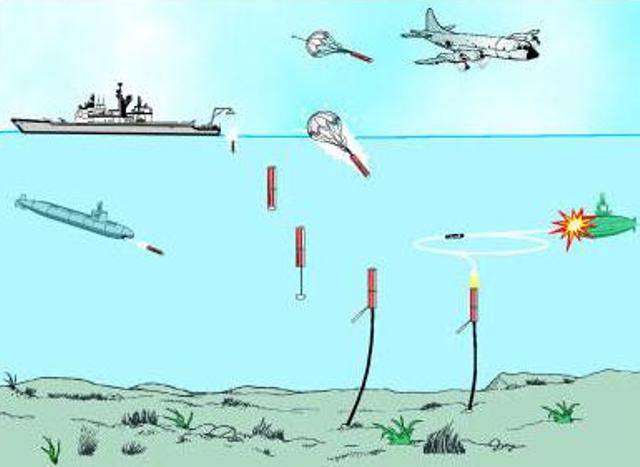
At the same time, aviation (including strategic bombers of the US Air Force) and submarines (for setting active minefields near the bases of the USSR Navy) were considered the main ones.
The CAPTOR mine has a total mass of 1040 kg, a length of 3683 mm (the boat version has a mass of 933 kg and a length of 3353 mm), a caliber of 533 mm.
Maximum installation depth data varies from 3000 ft (915 m) to 2000 ft.
The approximate target detection range is about 1500 meters, but this is true only for nuclear submarines of the Navy built in the mid-70s, and already on 3rd generation submarines (at low-noise moves) this figure was much lower.
Speaking about the non-contact equipment of the CAPTOR mine, it is necessary to note the extreme brevity of its description in Western literature, and moreover, the presence of direct disinformation in it (given the specifics of the issue, it is not at all surprising).
As a warhead, a special modification of the small-sized torpedo Mk 46 (Mod 4) was used. Measures to dock mines with a new (at the end of the 80s) modification of the Mk 46 Mod 5 were completed by 1989, but the consequences did not mean the termination of the serial production of CAPTOR.
CAPTOR mines were actively used by the US Navy and Air Force during combat training in the 80s (for which there was a practical version of the Mk66), however, a significant reduction in budget spending in the 1990s - 2000s sharply reduced the intensity of the use of CAPTOR, with a complete withdrawal from ammunition (to the warehouse) by the beginning of 2010.
Russian torpedo mines
The USSR Navy first created a mine with a moving missile warhead (it will not be superfluous to note here - that only thanks to the initiative officer B.K.Lyamin and his appeal in September 1951 with a letter to I.V. Stalin after the industry tried "Bury" a promising topic). Site link allmines.netto the page of the world's first mines with a moving warhead KRM.
Having started work on torpedo mines after the Americans, we were the first to successfully complete the development with the adoption of torpedo mines (and the deployment of its serial production).
From the site allmines.netpage mines PMT-1
In 1962, the chief designer V.V. Ilyin developed a pre-sketch design of a torpedo mine.
Since 1963, the project of the mine-torpedo (theme "Pilot") was headed by L.V. Vlasov, who was 33 at the time.
In 1964, the preliminary design was completed and defended. The SET-40 torpedo was adapted as a warhead, which received the code SET-40UL.
In 1965 the Dvigatel plant manufactured an experimental batch of mines.
In 1966, chief designer L.V. Vlasov. Since 1967, further work on the topic "Pilot" was continued by A.D. Bots. By this time, the unique, unparalleled in the world, rocket mines A.D. Botov RM-2 and RM-2G, which to this day, 50 years later, are in service and under the code MShM-2 (sea shelf mine) are exported.
All problems were solved, and in 1968 the mine successfully passed the factory tests.
In 1971, the world's first anti-submarine mine and torpedo complex was put into service.
The creation of subsequent mines-torpedoes of the Navy was influenced by the appearance of the Captor and the desire to obtain the radius of the mine's danger zone (target detection) "no less than the Americans." The beginning of this stories was scandalously instructive.
From the book of the ex-deputy head of the Anti-Submarine Warfare Directorate (UPV) of the Navy R.A. Gusev "Foundations of the minersky craft" St. Petersburg, 2006:
The quarrel occurred precisely on the basis of indirect data about the Captor mine, included by the NIMTI (Research Mine and Torpedo Institute) in the report to the higher authorities ... The Americans found how many mines they plan to place on the Faro-Icelandic anti-submarine line, measured the length of this line, which was divided into three times the first. The response radius significantly exceeded that of our PMT-1 ... The numbers were "hammered" into the report and boldly signed: I. Belyavsky (head of the mine department of NIMTI).
The first to react was the Deputy Commander-in-Chief of the Navy, Smirnov N.I., who carefully read all such reports. He urgently summoned Kostyuchenko (chief of the mine department of the UPV) and asked:
- How could you allow the adoption of the PMT-1 mines, obviously inferior to the Captor mine?
Kostyuchenko, not knowing why all the fuss, began verbal maneuvering, to clarify from which side the wind was blowing:
- There is no such information ... And where did you get the information, Comrade Admiral fleet? When we adopted the PMT-1, the Americans had nothing, you remember ...
- What was the detection range in the TTZ?
Kostyuchenko answered.
- Here you go. What century do you live in the UPV? You need to order 3-5 km. Not less.
- You can order and 10. Only to do it now is impossible. Where did you get this information?
- Data should be analyzed for all sources. You must have your head on your shoulders. Know at least fractions ...
- Give me a week of time. I'll figure it out. I'll report it. ...
A couple of days later, Kostyuchenko was already at the Central Committee, on the Old Square at I.V. Koksakov:
- We have information, comrade. Kostyuchenko that the Americans seriously bypassed us in mine weapons.
... Koksakov made a wave of his hand and a couple of leaves started from the table to the floor, where Kostyuchenko was sitting ... A tenacious glance tore out of the text "in the opinion of NIMTI."
In the morning Kostyuchenko was at NIMTI, in Belyavsky's office:
- Igor, tell me where did you get the information about the Captor? Those in the General Staff, Central Committee, military-industrial complex.
- How did you get it? Very simple. They took information from various sources ... One reported the number of mines at the turn. Well, we measured the length of this "fence" on the map - and the most secret information is in our pocket.
- Well, let's say you can divide. Did you take into account that they estimated the effectiveness of such a barrier in the same source at 0,3? In our calculations, we proceed from the probability of meeting a mine of 0,7.
Belyavsky was at a loss:
- We did not take this into account.
Kostyuchenko continued:
- This is where you got the Captor's higher performance characteristics. So, Igor, prepare an addendum to your report today and send it to the General Staff and the Central Committee tomorrow.
- I won't ...
“Well then, I'll have to fire you in two weeks.
- Don't get excited, I'm going to retire myself. Only ... not two weeks, but a quarter. And then, there is no reason.
- I told you the reason: I misled the country's top leadership ... I take the order of the Minister of Defense. Be healthy, Igor.
... The order to dismiss Belyavsky came in 12 days.
From the book "Foundations of the Minersky Craft" samples of broadband mines of the USSR Navy, years of adoption and main developers:
The export version of the torpedo mine received the designation PMK-2:
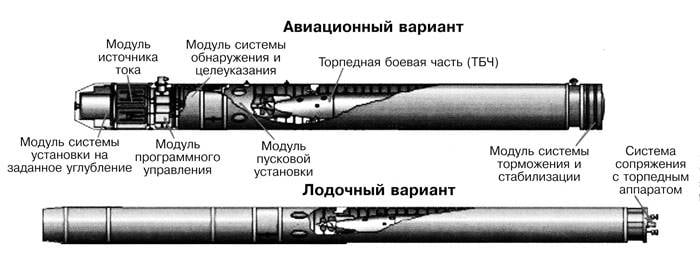
Device mines-torpedoes PMK-2 (Marine mine weapons. Book 1).
Here it is necessary to note two key problems of broadband mines: the possibility of their massive placement to achieve the required effectiveness of minefields (which required compactness, moderate mass and cost of mines) and an even more acute problem - the target detection range (response) of a broadband mine. The severity of the last question is clearly shown in the conflict between the heads of the mine departments of NIMTI and the UPV.
With the compactness we have turned out "not very". Despite the fact that in terms of performance characteristics, MTPK formally "surpassed" Captor, in reality, alas, it was "skillful manipulation of numbers." For example, the superiority of the MTPK in the depth of setting was "forced" - to somehow use the large dimensions of our mines for good. For 8% of real missions of anti-submarine torpedo mines, the depth of the Captor was quite enough. Most importantly, the overall dimensions and weight of our MTPK sharply limited the capabilities of carriers and fleets to install effective minefields, while the Captor had a dimension close to our RM-0G, which provided twice the ammunition load of mines on submarines (in relation to torpedoes).
A similar solution was applied by the US Navy to the Captor.
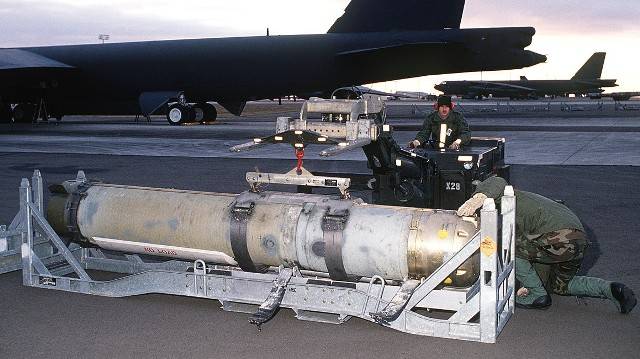
Mine CAPTOR prepared for suspension on B-52. The compactness of the mine is clearly visible.
However, an even more critical problem for the United States (taking into account a significant reduction in the noise level of domestic submarines), and especially for the USSR and the Russian Federation, was the detection (response) range of mines.
From the article (2006) of the General Director of KMPO "Gidropribor" S.G. Proshkina:
We “valiantly failed” the last one, the last boss who tried to do something serious in this direction was just S.G. Proshkin, but he was "resigned" from his post at the end of 2006 (and he himself died untimely in 2010).
But the USA did it ...
Hammerhead as CAPTOR at a new technological and conceptual level
Taking into account the sharp decrease in the noise of the submarines of the USSR Navy, the effectiveness of Captor dropped significantly, and in this connection, from the end of the 80s, research began on promising options for broadband mine systems, both by the US Navy and by US firms. An example of the latter is the ISBHM mine project.
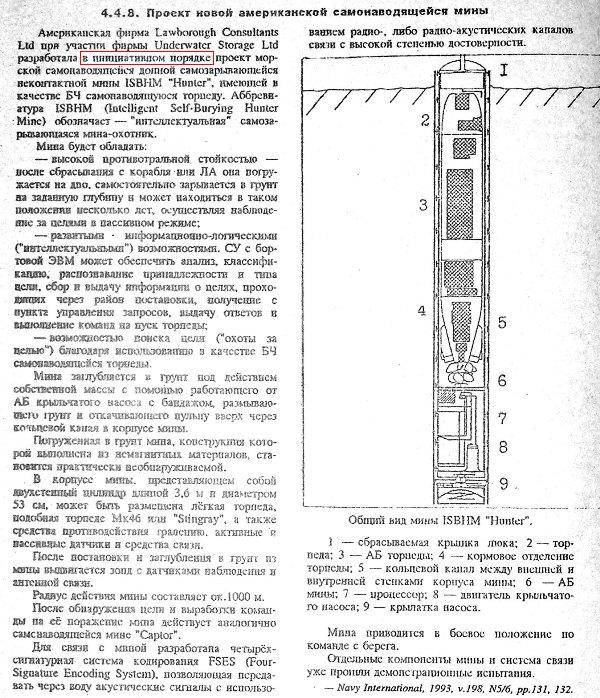
However, in the face of a significant reduction in defense spending in the 90s, all these promising studies and research never became real developments.
And now the news about the real (and moreover - forced) development of the American Hammerhead mine.
On February 27, 2020, the United States Naval Systems Command (NAVSEA) announced a tender for the design, development and production of a new sea mine, code-named Hammerhead, with particular emphasis on the ability to deploy multiple Hammerhead mines from unmanned underwater vehicles. The final request for proposals is to be published by the fall, with a contract awarded for the full development and testing of up to 30 prototypes in FY2021.
Actually, all this has been known for a long time, and has been publicly voiced since the 2000s.
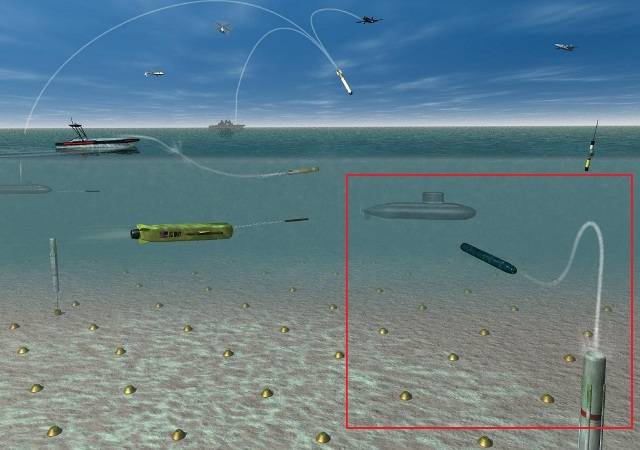
From presentations of the US Navy in the mid-2000s.
However, until recently, these were only preliminary studies and presentations. The real work on the development of new min-torpedoes in the United States began in 2018. This was publicly announced in a talk by Captain Daniel George, program manager for the U.S. Navy's Mine Action Services, at the National Defense Industry Association's (NDIA) Annual Expeditionary War Conference on October 16, 2018.
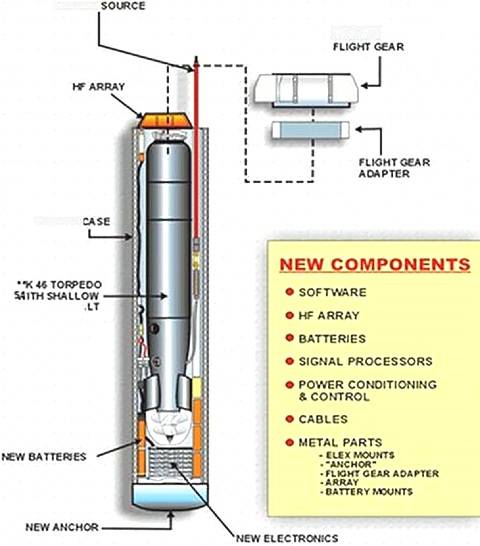
Hammerhead diagram showing new systems used with the Mk 60 CAPTOR
Note: based on the published scheme, an old Mk46 torpedo is used (with repair and modernization), which is quite logical and natural, and this should be a very serious lesson for the Russian Navy
From the article "Russia's naval underwater weapons today and tomorrow. Will the breakthrough be made out of the torpedo crisis":
The Americans did just that, again unlike us.
Conclusions:
1. The Hammerhead mine is actually a deep modernization (moreover, from the existing stock and ammunition) of the previously released CAPTOR mines.
2. Through the use of new technologies, it is planned to ensure not only the preservation of the CAPTOR hazardous area for modern low-noise targets, but also its significant increase.
3. The main producers of Hammerhead mines will be aircraft and submarines of the US Navy, and for the latter, as a rule, with the use of heavy combat aircraft.
A complete analysis of the combat effectiveness of the Hammerhead mine, the features of its use and place in the US weapons system is impossible without an excursion into the history of the US Navy mine weapon, the evolution of its appearance, views on its use and place in the US strategy (that's right!), The operational art of the Navy and Air Force ( !) USA.
Consideration of these issues (with lessons and conclusions for the Russian Navy) - in the next article.

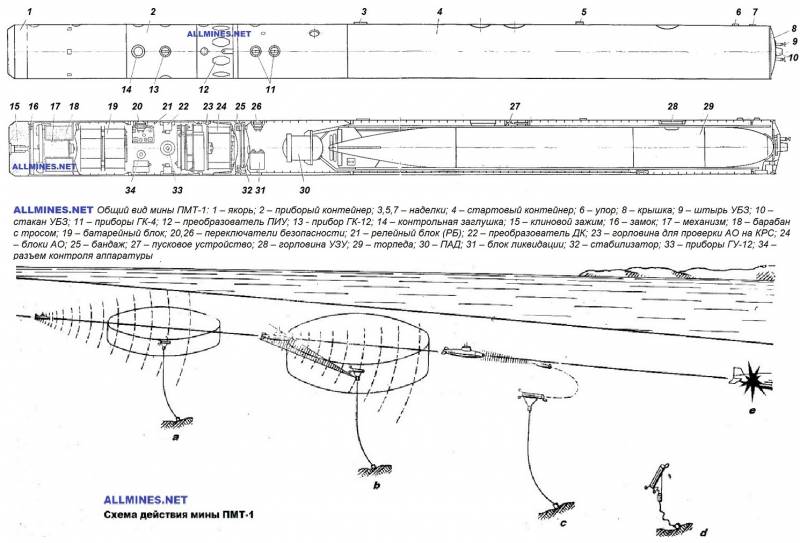
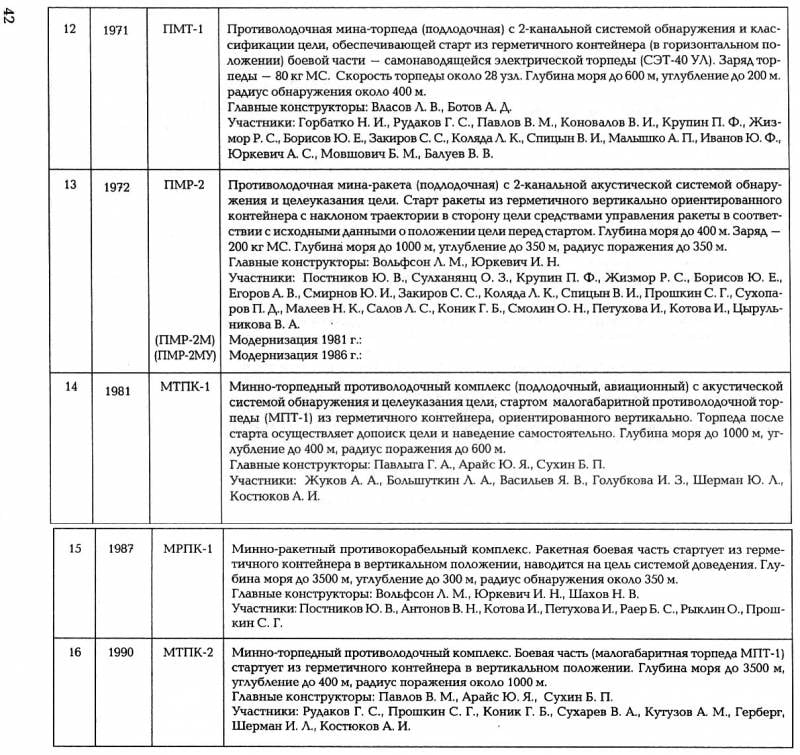
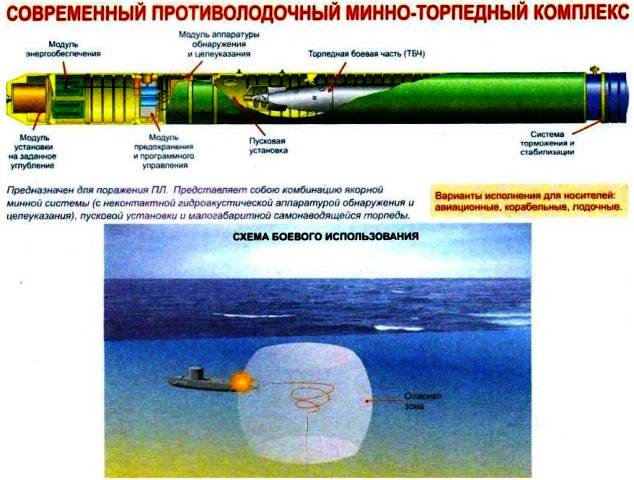
Information